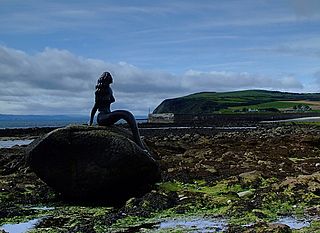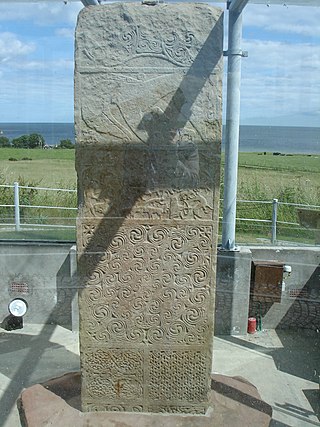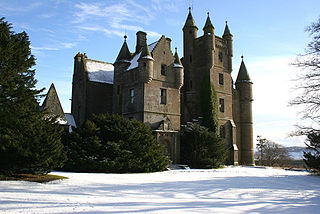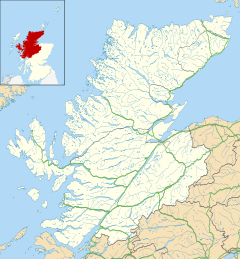
Clan Ross is a Highland Scottish clan. The original chiefs of the clan were the original Earls of Ross.
Balintore Football Club was a senior football club in Scotland. They played at Seaboard Park in Balintore, representing the Seaboard Villages in the Scottish Highlands.

A Pictish stone is a type of monumental stele, generally carved or incised with symbols or designs. A few have ogham inscriptions. Located in Scotland, mostly north of the Clyde-Forth line and on the Eastern side of the country, these stones are the most visible remaining evidence of the Picts and are thought to date from the 6th to 9th century, a period during which the Picts became Christianized. The earlier stones have no parallels from the rest of the British Isles, but the later forms are variations within a wider Insular tradition of monumental stones such as high crosses. About 350 objects classified as Pictish stones have survived, the earlier examples of which holding by far the greatest number of surviving examples of the mysterious symbols, which have long intrigued scholars.
Portmahomack is a small fishing village in Easter Ross, Scotland. It is situated in the Tarbat Peninsula in the parish of Tarbat. Tarbat Ness Lighthouse is about three miles from the village at the end of the Tarbat Peninsula. Ballone Castle lies about one mile from the village.

Hill of Fearn is a small village near Tain in Easter Ross, in the Scottish council area of Highland.

Easter Ross is a loosely defined area in the east of Ross, Highland, Scotland.

Balintore is a village near Tain in Easter Ross, Scotland. It is one of three villages on this northern stretch of the Moray Firth coastline: Hilton, Balintore, and Shandwick are known collectively as the Seaboard Villages.
Hilton of Cadboll, or simply Hilton, is a village about 15 km (9 mi) southeast of Tain in Easter Ross, in the Scottish council area of Highland. It is famous for the Hilton of Cadboll Stone.
The Seaboard Villages are three contiguous coastal villages, situated about 10 km southeast of the town of Tain in Easter Ross, Scotland. They face east onto the Moray Firth.

Fearn railway station is a railway station serving the village of Hill of Fearn in the Highland council area of Scotland, located around 1.3 miles (2.1 km) from the village. It is situated on the Far North Line, 40 miles 60 chains (65.6 km) form Inverness, between Tain and Invergordon, and is also the nearest station to Balintore, Hilton and Shandwick, Portmahomack and the Nigg Bay area of Easter Ross. ScotRail, who manage the station, operate all services.

The Clach a' Charridh or Shandwick Stone is a Class II Pictish stone located near Shandwick on the Tarbat peninsula in Easter Ross, Scotland. It is a scheduled monument.
The Portmahomack sculpture fragments are the slabs and stone fragments which have been discovered at the Easter Ross settlement of Portmahomack (Tarbat), Scotland.
Rockfield is a hamlet in the parish of Tarbat, on the Tarbat Peninsula, near the village of Portmahomack, Easter Ross, Highland, Scotland. There is a small stone jetty and the traditional way of life included fishing and agriculture. Rockfield is generally east-facing, below the level of a raised beach.

Balintore Castle is a Victorian Category A listed building in Scotland.

Woodside is an area of Aberdeen. It came into existence as a quoad sacra parish within the parish of Old Machar in 1834, under an act of The General Assembly of the Church of Scotland of 31 May 1834, and was named for the principal residence of the area, Woodside House.

The West End is an affluent district of Edinburgh, Scotland, which along with the rest of the New Town and Old Town forms central Edinburgh, and Edinburgh's UNESCO World Heritage Site. The area boasts several of the city's hotels, restaurants, independent shops, offices and arts venues, including the Edinburgh Filmhouse, Edinburgh International Conference Centre and the Caledonian Hotel. The area also hosts art festivals and crafts fairs.

Balintore is a village in Angus, Scotland. It lies in Glen Isla, four miles north of the Loch of Lintrathen and seven miles west of Kirriemuir. Approximately half a mile to the east is Knowehead of Auldallan farm, where there can be found a pair of uninscribed standing stones.
Balintore can refer to several places in Scotland:
This page is based on this
Wikipedia article Text is available under the
CC BY-SA 4.0 license; additional terms may apply.
Images, videos and audio are available under their respective licenses.











